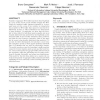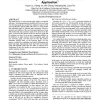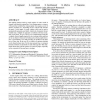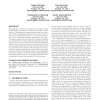WSDM
2009
ACM
14 years 9 months ago
2009
ACM
WSDM
2009
ACM
14 years 9 months ago
2009
ACM
This paper focuses on ‘user browsing graph’ which is constructed with users’ click-through behavior modeled with Web access logs. User browsing graph has recently been adopt...
WSDM
2009
ACM
14 years 9 months ago
2009
ACM
Text streams are becoming more and more ubiquitous, in the forms of news feeds, weblog archives and so on, which result in a large volume of data. An effective way to explore the...
WSDM
2009
ACM
14 years 9 months ago
2009
ACM
Recently the re-ranking algorithms have been quite popular for web search and data mining. However, one of the issues is that those algorithms treat the content and link informati...
WSDM
2009
ACM
14 years 9 months ago
2009
ACM
The ranking function used by search engines to order results is learned from labeled training data. Each training point is a (query, URL) pair that is labeled by a human judge who...
WSDM
2009
ACM
14 years 9 months ago
2009
ACM
WSDM
2009
ACM
14 years 9 months ago
2009
ACM
Automatically clustering web pages into semantic groups promises improved search and browsing on the web. In this paper, we demonstrate how user-generated tags from largescale soc...
WSDM
2009
ACM
14 years 9 months ago
2009
ACM
We study the problem of answering ambiguous web queries in a setting where there exists a taxonomy of information, and that both queries and documents may belong to more than one ...
WSDM
2009
ACM
14 years 9 months ago
2009
ACM
WSDM
2009
ACM
14 years 9 months ago
2009
ACM
With the overwhelming number of reports on similar events originating from different sources on the web, it is often hard, using existing web search paradigms, to find the origi...




